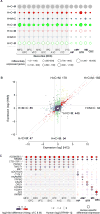Molecular and cellular reorganization of neural circuits in the human lineage
- PMID: 29170230
- PMCID: PMC5776074
- DOI: 10.1126/science.aan3456
Molecular and cellular reorganization of neural circuits in the human lineage
Abstract
To better understand the molecular and cellular differences in brain organization between human and nonhuman primates, we performed transcriptome sequencing of 16 regions of adult human, chimpanzee, and macaque brains. Integration with human single-cell transcriptomic data revealed global, regional, and cell-type-specific species expression differences in genes representing distinct functional categories. We validated and further characterized the human specificity of genes enriched in distinct cell types through histological and functional analyses, including rare subpallial-derived interneurons expressing dopamine biosynthesis genes enriched in the human striatum and absent in the nonhuman African ape neocortex. Our integrated analysis of the generated data revealed diverse molecular and cellular features of the phylogenetic reorganization of the human brain across multiple levels, with relevance for brain function and disease.
Copyright © 2017, American Association for the Advancement of Science.
Figures






References
-
- Preuss TM. What is it like to be a human. In: Gazzaniga MS, editor. The Cognitive Neurosciences. MIT Press; Cambridge, MA: 2004. pp. 5–22.
-
- Teffer K, Semendeferi K. Human prefrontal cortex: evolution, development, and pathology. Prog. Brain Res. 2012;195:191–218. - PubMed
Publication types
MeSH terms
Grants and funding
- R01 AG048918/AG/NIA NIH HHS/United States
- R01 GM094780/GM/NIGMS NIH HHS/United States
- 260372/ERC_/European Research Council/International
- UL1 TR001863/TR/NCATS NIH HHS/United States
- HHMI/Howard Hughes Medical Institute/United States
- S10 OD018521/OD/NIH HHS/United States
- R24 NS092988/NS/NINDS NIH HHS/United States
- UG3 MH120095/MH/NIMH NIH HHS/United States
- U01 MH103339/MH/NIMH NIH HHS/United States
- R01 MH109904/MH/NIMH NIH HHS/United States
- U01 MH106874/MH/NIMH NIH HHS/United States
- R01 DK111178/DK/NIDDK NIH HHS/United States
- P50 MH106934/MH/NIMH NIH HHS/United States
- R01 MH110926/MH/NIMH NIH HHS/United States
- RF1 MH114126/MH/NIMH NIH HHS/United States
LinkOut - more resources
Full Text Sources
Other Literature Sources
Research Materials
Miscellaneous

